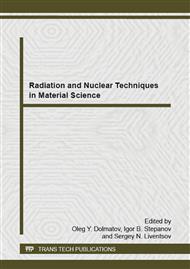p.7
p.11
p.16
p.21
p.26
p.30
p.34
p.38
p.42
Formation of Shear Zone's Defect Structure in F.C.C. Metals
Abstract:
As a result of the work of Frank-Read dislocation source the shear zone is formed. It is filled with deformation defects forming as a consequence of the dynamic features of the motion of dislocation loops and due to the interaction of shear forming dislocations with dislocations of non-coplanar slip systems. The accumulation of jogs on screw segments leads to the fact that the edge segments are moving faster than the screw segments so the shear zone is swept out generally by screw segments. The expressions of the intensities of the deformation defects accumulation in shear zones are given in the article. The point defects plays special role in the formation and evolution of misorientation substructures into deformed monocrystals, polycrystals and nanocrystals.
Info:
Periodical:
Pages:
26-29
Citation:
Online since:
January 2015
Price:
Сopyright:
© 2015 Trans Tech Publications Ltd. All Rights Reserved
Share:
Citation:


